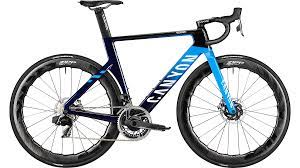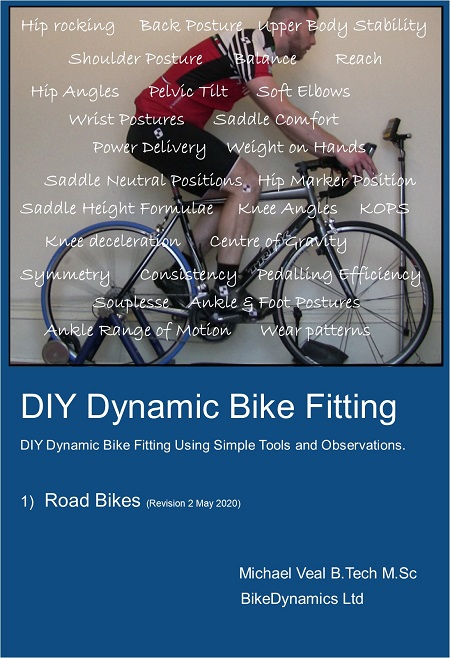Cycling Aerodynamics

Aerodynamic Drag Equation
You may have read the -Basic Aerodynamics- page on this site outlining the principles of Skin Friction, Pressure Drag and Pressure Recovery, how this will contribute to CdA and the cubed relationship between airspeed and power requirement. This page brings this into the cycling environment, with our attempt at ranking the means available to us to reduce our aerodynamic drag and go faster.

Body Position.
As Bike Fitters, one could well imagine that we would say that Bike Position is the most important factor in reducing our aerodynamic drag, but it clearly is! If we go back to the basic aerodynamics equations it is only really 'Cd' and 'A' where we can make changes. In the past, with very limited access to windtunnels, improving 'Cd' was a best guess, but 'A' relatively simple. Placing a mirror in front of the bike on a turbo trainer can be very informative as you try to make yourself as small as possible. People have taken photographs, cut them out and weighed them on accurate scales. Counting pixels on digital images uses a similar philosophy. Today Apps exist that will do this for you digitally.
All of these techniques drive us to be as low and as narrow as we can. Leaning further forwards and getting our heads and shoulders as low as possible is ultimately constrained by a loss of power or comfort, but absolutely essential to reduce A. Our position will also influence the Cd part of the equation. A low flat back will help to maintain flow attachment around the shoulders and down the spine. Horizontal forearms with the hands on the hoods could offer both Cd and A improvements over a drops position.

Cycling Attire for Drag Reduction
After Body Position, the next most significant aerodynamic improvement to be made is via your attire. On a very basic level, close fitting clothing will not increase your surface area A. In many areas, tight, smooth, non-flappy materials will encourage laminar flow around the body, minimising pressure drag. Choice of material here is also relevant for Skin Friction. In other areas where flow separation is inevitable, texture in the material will provided the necessary 'trip' to instigate some turbulence and maintain attachment for longer. We are increasingly seeing this on the shoulders and on socks. Aero shoe covers can be very useful, especially when you consider the windspeed of the foot coming forwards over the top of the pedal stroke will be significantly faster than the bike windspeed.

Wheels
Deep section Aero wheels are on every Time Triallists and Triathletes shopping list, and rightly so. In simple terms. these work by maintaining attached flow around the rim section for as long as possible. The tyre itself forms the leading edge of the section. Ideally the tyre width will be slightly narrower than the wheel's widest point to avoid sharp transitions. There is some evidence that tyre sipes (treads) can act as aero trips. Wheels and tyres have become much wider in recent years, which is contrary to our thoughts on minimising A, but in this case, the improvement to Cd outweighs the increase in A. Bladed spokes are a feature of many aero wheelsets. One advantage of increasingly deeper rims is that this reduces the significance of the spokes. As a rule, rim depths of 40-50mm offer the best aerodynamic performance without compromising weight or cross wind stability. Heavier riders may find they can run deeper section front wheels without being blown around as much.

Aero Helmets
Aero Helmets come in a variety of shapes and sizes, from the non-vented, fully faired types favoured by Time Triallists to the more conventional road helmets with minimal or cleverly designed vents to minimise drag whilst maintaining some ventilation. The problem here is that our heads are both very vulnerable and tend to stick up into the wind, more often than not so that we can see where we are going!

Aero Bikes
Road bikes with specific attention paid to aerodynamic design have become increasingly common and popular in recent years. The key features of such bikes (as well as the wheels) will be hidden cabling, wing section handlebar tops, frame sections and D section seat posts. Attention will also be paid to the interfaces between fork and frame, and the interactions between wheels and frame.
Masking
When considering the individual benefits of aerodynamic features, it is essential to understand the overall package. Many items such as helmets, clothing and wheels are sold on the promise of saving so many Watts (e.g 10W) at 35kph, but that will be based on that test environment on that day. Lets take the example of an aero helmet worn by a small person on a well fitted TT bike with deep section wheels and tight clothing. For the sake of argument, lets also assume they require 175W to maintain 35kph on a flat road. In this case the 10W improvement over their standard helmet will be worthwhile and measureable. Fitting the same helmet to a larger person on a standard road bike with sub optimal clothing and position could well be lost in any experimental error as their power requirement may be doubled. Considering how benefits may be 'masked' does lead us to consider going 'all in' if looking to significantly improve our aerodynamics, with position, clothing and wheels a minimum requirement.
DIY Dynamic Bike Fitting
You may be interested in our downloadable DIY guide.
49 Page PDF download describing all the observations, simple measurements and calculations required to do your own Dynamic Bike Fits.
Revision 2 released May 2020.
Contains updated male and female saddle height calculators and new information on male / female leg length proportions. Plus a new section to assist with saddle choice and improving comfort.
British Pound, Euro and US Dollar payments are processed by PayPal and all major credit cards are accepted. You will receive an email confirming your payment and will be automatically redirected to a page where you can download the ebook. The ebook is in PDF format so you will need to have a copy of Adobe Acrobat Reader or a similar PDF reader to read the ebook.


